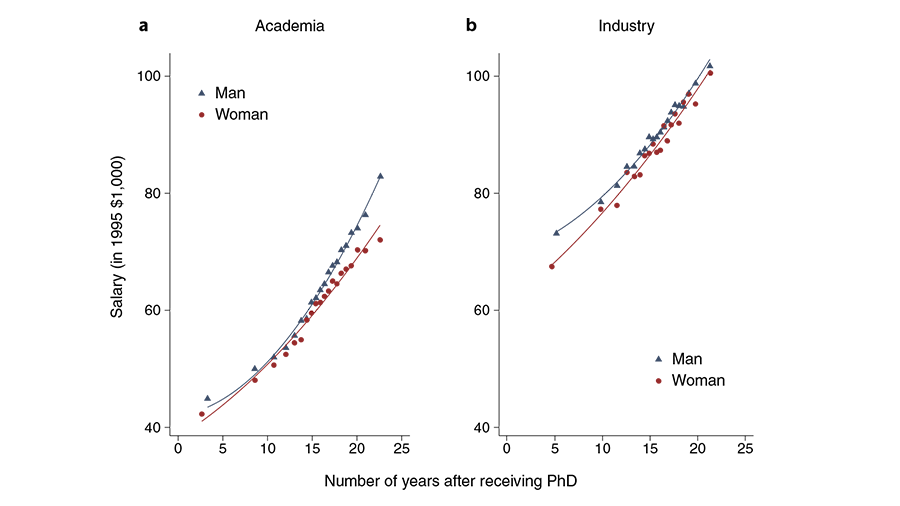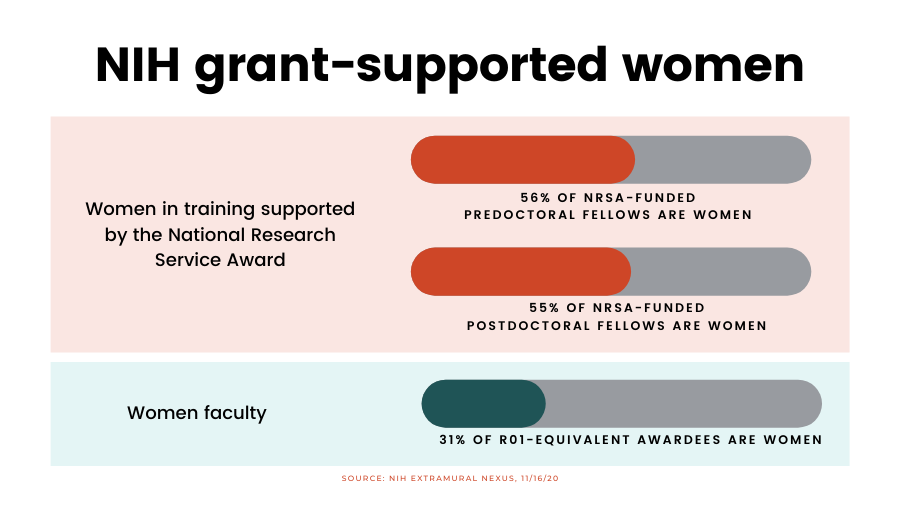Underpaid: Women scientists in the academy
It may not be surprising to many of us women scientists who work at universities and colleges that we are underpaid compared with our colleagues who are men. Yet an analysis in the journal Nature Biotechnology in fall 2021 revealed that the gender pay gap is smaller for women who work in biotechnology and pharma.
This remarkable finding has negative implications for retaining the next generation of women in academic science — and for reaching diversity, equity and inclusion goals at our universities and colleges.

Using National Science Foundation data from 1995 to 2017, Waverly W. Ding, Atsushi Ohyama and Rajshree Agarwal examined the salaries of 34,421 full-time scientists employed in either academia or industry (for-profit firms). They compared inflation-adjusted salaries in both sectors, controlling for a number of variables. Thirty percent of the scientists were women.
Their major finding was that the gender pay gap is 1.5 times wider in academia than in industry, with women in academia earning 5.3% less than the men (see graph). Also notable is the clear difference in the overall salary range in academia versus industry for both men and women, with industry having significantly higher salaries than academia.
How did this come to be?
For starters, women are more likely than men to be employed in non–tenure track positions. The authors found that the gender wage gap occurs only in the non–tenure track positions.
In contrast, in industry, although women scientists are underrepresented in leadership positions, the authors detected no gender wage gap in nonleadership positions.
They conclude that because women sort themselves into non–tenure track positions in academia, they experience salary inequity throughout their careers. In the long term, the non–tenure track also largely denies women leadership roles in policy setting at the university and college level.
A known issue
In 2020, the National Institutes of Health Office of Extramural Research examined gender disparities among NIH-supported scientists at various career stages.
In a blog post, OER Deputy Director Mike Lauer pointed out that women leak out of the pipeline specifically at the juncture between postdoctoral fellowship and independent, research-focused faculty position. Although women receive 56% and 55% of pre- and postdoctoral National Research Service Award fellowship grants respectively, only 31% of the R01-equivalent grants go to women (see infographic).

A reasonable assumption would be that most R01 grants are garnered by women who hold tenure track faculty positions. The NIH data are thus consistent with those of Ding et al. in that they demonstrate that women leave the tenure track in academia at a higher rate than men. At the same time, the NIH finds that the sorting of women into non–tenure track positions occurs before they would have garnered an independent faculty position.
Critical questions at the root of the gender wage gap in academia, then, are: Why do women with Ph.D.s in the biological sciences sort themselves into the non–tenure track at a higher rate than men? And why do they then earn less there? Undoubtedly the answers will turn out to be complex.
Negotiating as a woman
One contributing factor to the gender wage gap is likely the problem of negotiating — either because women are socialized not to want to seem pushy or because we fear the backlash if we do negotiate assertively.
Recent work published in the Journal of Applied Psychology and highlighted in Forbes argues that women negotiate better when they have an alternate choice. If a woman is the trailing partner in a dual-career couple academic hire, she is less likely to have that choice. I should know: As an assistant professor, I was the lowest paid person at my rank for some years.
Tools for negotiating effectively as women are found in the work of Linda C. Babcock of Carnegie Mellon University’s Heinz College and colleagues, highlighted in Iris Bohnet’s book “What Works: Gender Equality by Design.” They argue that women are more effective at negotiating their salaries when they know what to ask for. Salary transparency is key here — information that is hard to come by at private universities and colleges.
Another tactic is to invoke a silent partner in salary negotiations. For example, instead of asking for more compensation on behalf of myself, I would say that my mentor, adviser or coach insisted that I ask for a higher salary or for more equitable laboratory resources. Studies have shown that this feint helps women avoid backlash.
Taking the long view, to preserve the nation’s investment in women with Ph.D.s in the biological sciences, universities and colleges must do better at recruiting and retaining women in academic tenure track faculty positions. This is also critical to preserve access to a diverse group of mentors and role models for future generations of scientists.
We must get to the bottom of the leaky pipeline for women scientists in academia and finally fix it.
Enjoy reading ASBMB Today?
Become a member to receive the print edition four times a year and the digital edition monthly.
Learn moreFeatured jobs
from the ASBMB career center
Get the latest from ASBMB Today
Enter your email address, and we’ll send you a weekly email with recent articles, interviews and more.
Latest in Opinions
Opinions highlights or most popular articles

The tortoise wins: How slowing down saved my Ph.D.
Graduate student Amy Bounds reflects on how slowing down in the lab not only improved her relationship with work but also made her a more productive scientist.

How pediatric cataracts shaped my scientific journey
Undergraduate student Grace Jones shares how she transformed her childhood cataract diagnosis into a scientific purpose. She explores how biochemistry can bring a clearer vision to others, and how personal history can shape discovery.

Debugging my code and teaching with ChatGPT
AI tools like ChatGPT have changed the way an assistant professor teaches and does research. But, he asserts that real growth still comes from struggle, and educators must help students use AI wisely — as scaffolds, not shortcuts.

AI in the lab: The power of smarter questions
An assistant professor discusses AI's evolution from a buzzword to a trusted research partner. It helps streamline reviews, troubleshoot code, save time and spark ideas, but its success relies on combining AI with expertise and critical thinking.

How AlphaFold transformed my classroom into a research lab
A high school science teacher reflects on how AI-integrated technologies help her students ponder realistic research questions with hands-on learning.

Writing with AI turns chaos into clarity
Associate professor shares how generative AI, used as a creative whiteboard, helps scientists refine ideas, structure complexity and sharpen clarity — transforming the messy process of discovery into compelling science writing.

